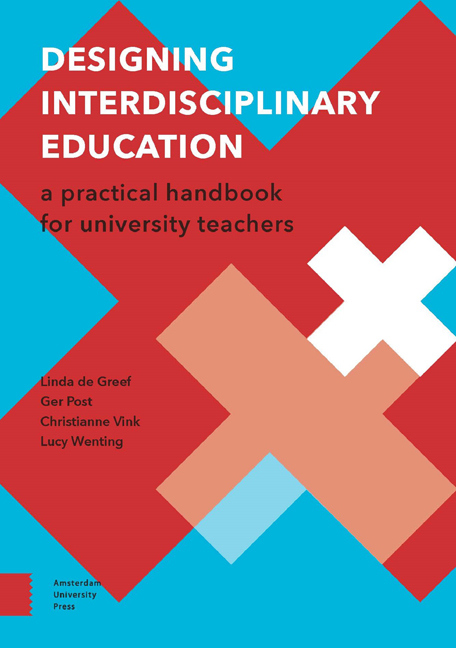Book contents
- Frontmatter
- Contents
- Acknowledgements
- 1 Introduction
- 2 An Overview of the Development Stages
- 3 Unravelling Interdisciplinary Understanding
- 4 Developing the Raw Sketch
- 5 Formulating Interdisciplinary Learning Outcomes
- 6 Embedding Integration in the Programme Design
- 7 Hiring and Engaging Faculty
- 8 Exploring the Teaching Philosophy and Didactic Methods
- 9 Assessment of Interdisciplinary Learning Outcomes
- 10 Interdisciplinary Teaching in Practice
- 11 Programme Assessment and Adjustment
- Appendices
- References
- Colophon
9 - Assessment of Interdisciplinary Learning Outcomes
- Frontmatter
- Contents
- Acknowledgements
- 1 Introduction
- 2 An Overview of the Development Stages
- 3 Unravelling Interdisciplinary Understanding
- 4 Developing the Raw Sketch
- 5 Formulating Interdisciplinary Learning Outcomes
- 6 Embedding Integration in the Programme Design
- 7 Hiring and Engaging Faculty
- 8 Exploring the Teaching Philosophy and Didactic Methods
- 9 Assessment of Interdisciplinary Learning Outcomes
- 10 Interdisciplinary Teaching in Practice
- 11 Programme Assessment and Adjustment
- Appendices
- References
- Colophon
Summary
‘Students can escape from the effects of poor teaching, but they cannot escape the effects of poor assessment.’
David Boud
Assessment is an important part of any (interdisciplinary) programme because it monitors whether students have reached the intended learning outcomes of the courses and, ultimately, the outcomes of the programme. It not only provides students with information on their development and progress, it also gives teachers information on the effectiveness of their teaching. In the literature on education, two forms of assessment – formative and summative – are recognised. The goal of formative assessment is to monitor student progress and to help students adjust and correct during the learning process. Summative assessment is meant to evaluate student learning and compare it to some benchmark (with grading). A metaphor that is often used for formative assessment is the cook tasting the soup, while summative assessment is when the guests taste the soup. This chapter will deal primarily with summative assessment. It provides an overview of appropriate assessment methods and best practices for interdisciplinary learning outcomes.
Valid assessment of interdisciplinary learning outcomes
One reason for assessing students is to evaluate whether the teaching has been effective. This is as important for interdisciplinary teaching as it is for disciplinary courses. A valid assessment measures to what extent the students have reached all the intended learning outcomes. This is best achieved by having the students engage in a specific activity that is based on the ‘active verb’ that is used in the intended learning outcomes for the course (see chapter 5). For instance, if the intended learning outcome is that ‘the student is able to explain the difference between a multi-disciplinary approach to the theme of addiction and the interdisciplinary approach to this theme’, a valid way of assessing whether the students have reached competence in this learning outcome is to ask the student to ‘explain the difference between a multidisciplinary and interdisciplinary approach to the theme of addiction’, for instance in a written exam. Then you are measuring exactly what you set out to measure.
This example shows that assessing the validity of intended learning outcomes aimed at the reproduction of facts or comprehension is often fairly easy.
- Type
- Chapter
- Information
- Designing Interdisciplinary EducationA Practical Handbook for University Teachers, pp. 121 - 137Publisher: Amsterdam University PressPrint publication year: 2017



